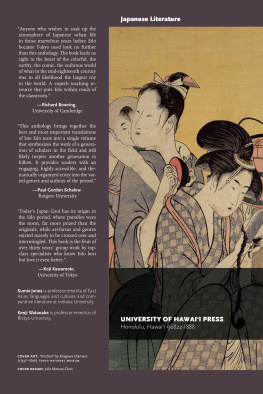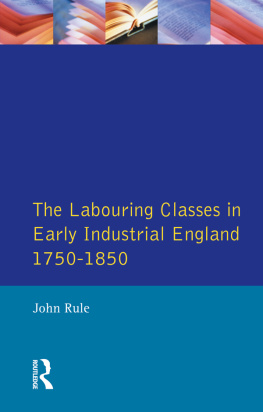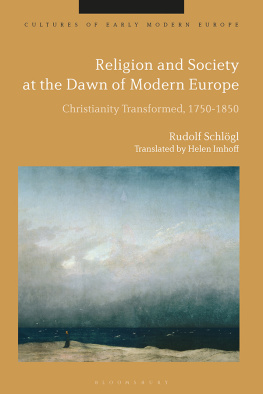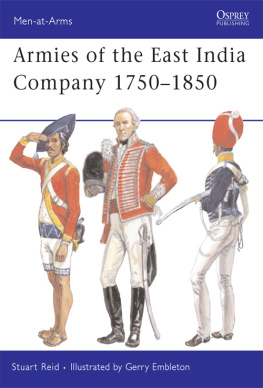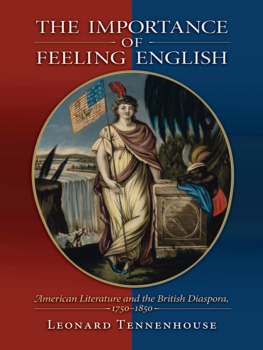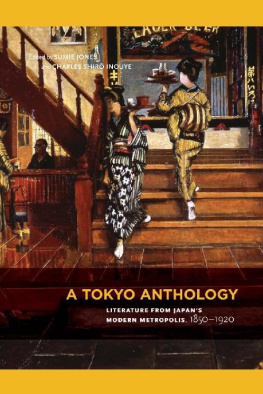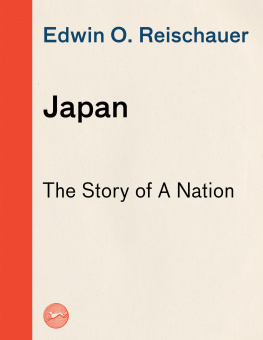Sumie Jones (Editor) - An Edo Anthology: Literature from Japan’s Mega-City, 1750-1850
Here you can read online Sumie Jones (Editor) - An Edo Anthology: Literature from Japan’s Mega-City, 1750-1850 full text of the book (entire story) in english for free. Download pdf and epub, get meaning, cover and reviews about this ebook. year: 2013, publisher: University of Hawaii Press, genre: Home and family. Description of the work, (preface) as well as reviews are available. Best literature library LitArk.com created for fans of good reading and offers a wide selection of genres:
Romance novel
Science fiction
Adventure
Detective
Science
History
Home and family
Prose
Art
Politics
Computer
Non-fiction
Religion
Business
Children
Humor
Choose a favorite category and find really read worthwhile books. Enjoy immersion in the world of imagination, feel the emotions of the characters or learn something new for yourself, make an fascinating discovery.
- Book:An Edo Anthology: Literature from Japan’s Mega-City, 1750-1850
- Author:
- Publisher:University of Hawaii Press
- Genre:
- Year:2013
- Rating:3 / 5
- Favourites:Add to favourites
- Your mark:
- 60
- 1
- 2
- 3
- 4
- 5
An Edo Anthology: Literature from Japan’s Mega-City, 1750-1850: summary, description and annotation
We offer to read an annotation, description, summary or preface (depends on what the author of the book "An Edo Anthology: Literature from Japan’s Mega-City, 1750-1850" wrote himself). If you haven't found the necessary information about the book — write in the comments, we will try to find it.
An Edo Anthology: Literature from Japan’s Mega-City, 1750-1850 — read online for free the complete book (whole text) full work
Below is the text of the book, divided by pages. System saving the place of the last page read, allows you to conveniently read the book "An Edo Anthology: Literature from Japan’s Mega-City, 1750-1850" online for free, without having to search again every time where you left off. Put a bookmark, and you can go to the page where you finished reading at any time.
Font size:
Interval:
Bookmark:



2013 UNIVERSITY OF HAWAII PRESS
All rights reserved
LIBRARY OF CONGRESS CATALOGING-IN-PUBLICATION DATA
An Edo anthology : literature from Japans mega-city, 17501850 /
edited by Sumie Jones with Kenji Watanabe.
pages cm
Includes bibliographical references.
ISBN 978-0-8248-3629-0 (cloth : alk. paper)
ISBN 978-0-8248-3740-2 (pbk. : alk. paper)
1. Japanese literatureEdo period, 16001868Translations into English.
I. Jones, Sumie, editor of compilation. II. Watanabe, Kenji, editor of compilation.
PL726.35.E27 2013 895.6'08003dc23
ISBN 978-0-8248-3776-1 (digital)
Publication of this book has been assisted by grants from the following organizations:
THE SUNTORY FOUNDATION

COVER
Commonly called Kitchen or Beauties in the Kitchen, this luxuriously colored diptych is by Kitagawa Utamaro (1753?1806), who obsessively portrayed the charms of Edo women of all types and classes. (Tokyo National Museum)
........................................
Contents
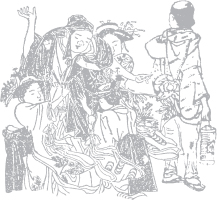
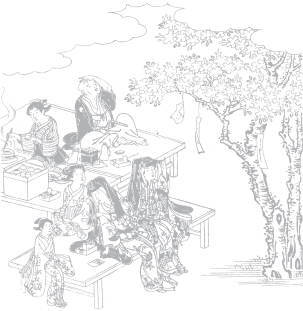
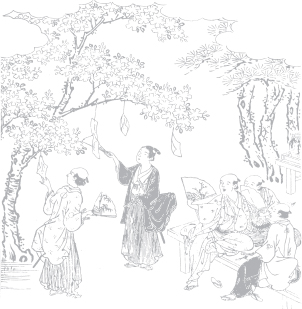
Preface
Popular literature as a creation that aims at general, non-elite consumption may go back to the Middle Ages. In Japan, increased literacy among commoners during the late eighteenth century and through the first half of the nineteenth century encouraged an exuberant growth of literary genres for the masses. What began as a pastime for the educated, chiefly samurai, came to involve merchants and other commoners, transforming this mixture of groups into the first professional writers for the newly developed publishing market. Edo, the rapidly growing metropolis that is now Tokyo, was both the hotbed for the production of this literature and its greatest market. This anthology presents some of the best examples of the burgeoning popular literature from 1750 to 1850.
We students of the periods literature are in debt to Howard Hibbett for the flourishing field of study we now enjoy in the United States. During the early 1980s, about a dozen of us began to gather under his leadership in the form of workshops and symposia, which later developed into a network for collaborative research and mutual teaching. The idea of an anthology in English came to Sumie Jones during 19981999 while she was in Tokyo pursuing collaborative research with Kenji Watanabe. A planning committee soon formed with the addition of Robert Campbell and Shinji Nobuhiro. We, the committee, discussed plans for engaging scholars and libraries internationally, occasionally inviting for consultation other specialists such as James Brandon, Chris Drake, Valerie Durham, and Adam Kabat.
Popular literature of the period is not easy to decipher for a modern reader. The cursive handwriting styles used in woodblock-printed books, the mixture of classical and colloquial speech, including class, regional, and professional dialects, and references to Japanese and Chinese literatures as well as to contemporary events and gossip make these texts particularly difficult. In addition, Edos place names, personal names, words concerning fashion and customs, and allusions to events of the time are often obscure to modern scholars. As explained in the introduction, time of the day, the calendar, measures, etc., were often approximate or otherwise changeable, which burdens the task of transposing Edo culture to the modern and to the realm of the English language. Thus, the study of Edo literature and culture in Japan is often conducted by groups who exchange information and collaborate to decipher the handwritten scripts used in the woodblock-printed texts. In preparing this anthology we followed their model. It took us some years of collaborative training, a project directed by Jones and funded by Toshiba International Foundation and the National Endowment for the Humanities. Within this process, the committee discussed possible texts for translation, keeping in mind the interests of prospective readers. In selecting translators the committee emphasized not only the contributors scholarship but also their writing style, making sure to mix distinguished scholar/translators with up-and-coming ones.
After the contributors began their translation work, the typical procedure during the preparatory training period continued. A translator would ask a question, which was answered by Jones unless Watanabes assistance was needed in looking up materials in Japan; when further information or advice was needed, Shinji Nobuhiro, the walking dictionary and leader of Edo studies in Japan, was consulted. Occasionally Nobuhiro turned to Hideyuki Iwata and about a dozen other experts in Japan. Hibbett, the legendary editor of Harvard Journal of Asiatic Studies, was consulted on all questions related to English idiom, writing style, and tone. While Jones checked each translation for errors against the original, Hibbett went over each for stylistic improvements. Other members of the original planning committee also helped. Robert Campbell provided the first reading for the translations of One Hundred Monsters in Edo of Our Time by William J. Farge, The Tale of the Eight Dog Warriors of the Satomi Clan by Ellen Widmer, and At a Fork on the Road to Hiring a Hooker by Sara Langer. Chris Drake went over the translation of Playboy, Grilled Edo Style by Jones, which had been edited by Hibbett and Jurgis Elisonas during the 1980s. Translators, needless to say, have been the chief players in the construction of this anthology: Not only have they taken part in debates with the coeditors, advisors, and occasional consultants, but they are the ones who have had the last word on interpreting each work. We are grateful to have had the opportunity to work with these talented and generous teammates. In most cases, the introduction to each translation was authored by its translator. In others, at the translators request, Jones either provided an introduction or coauthored one with the translator. The author of each introduction is identified by her or his initials at its end.
Although this volume includes many important writers and well-known works, it does not attempt a comprehensive representation of the history of Edo popular literature. The works are arranged neither in a chronological order nor according to genre categories but by themes through which the texts resonate with one another. Luckily for the purpose of this anthology, literary forms popular during the period of our concern are generally short: haiku is considered the shortest poetic form in the world and yellow book fiction was published in the form of ten- to twenty-page booklets. On the other hand, many of the novels that developed late in this period are extraordinarily long and kabuki plays often include a large number of scenes. Some of the most important and attractive works are too long to fit in the format of this volume, and these are presented here as short excerpts.
Next pageFont size:
Interval:
Bookmark:
Similar books «An Edo Anthology: Literature from Japan’s Mega-City, 1750-1850»
Look at similar books to An Edo Anthology: Literature from Japan’s Mega-City, 1750-1850. We have selected literature similar in name and meaning in the hope of providing readers with more options to find new, interesting, not yet read works.
Discussion, reviews of the book An Edo Anthology: Literature from Japan’s Mega-City, 1750-1850 and just readers' own opinions. Leave your comments, write what you think about the work, its meaning or the main characters. Specify what exactly you liked and what you didn't like, and why you think so.

